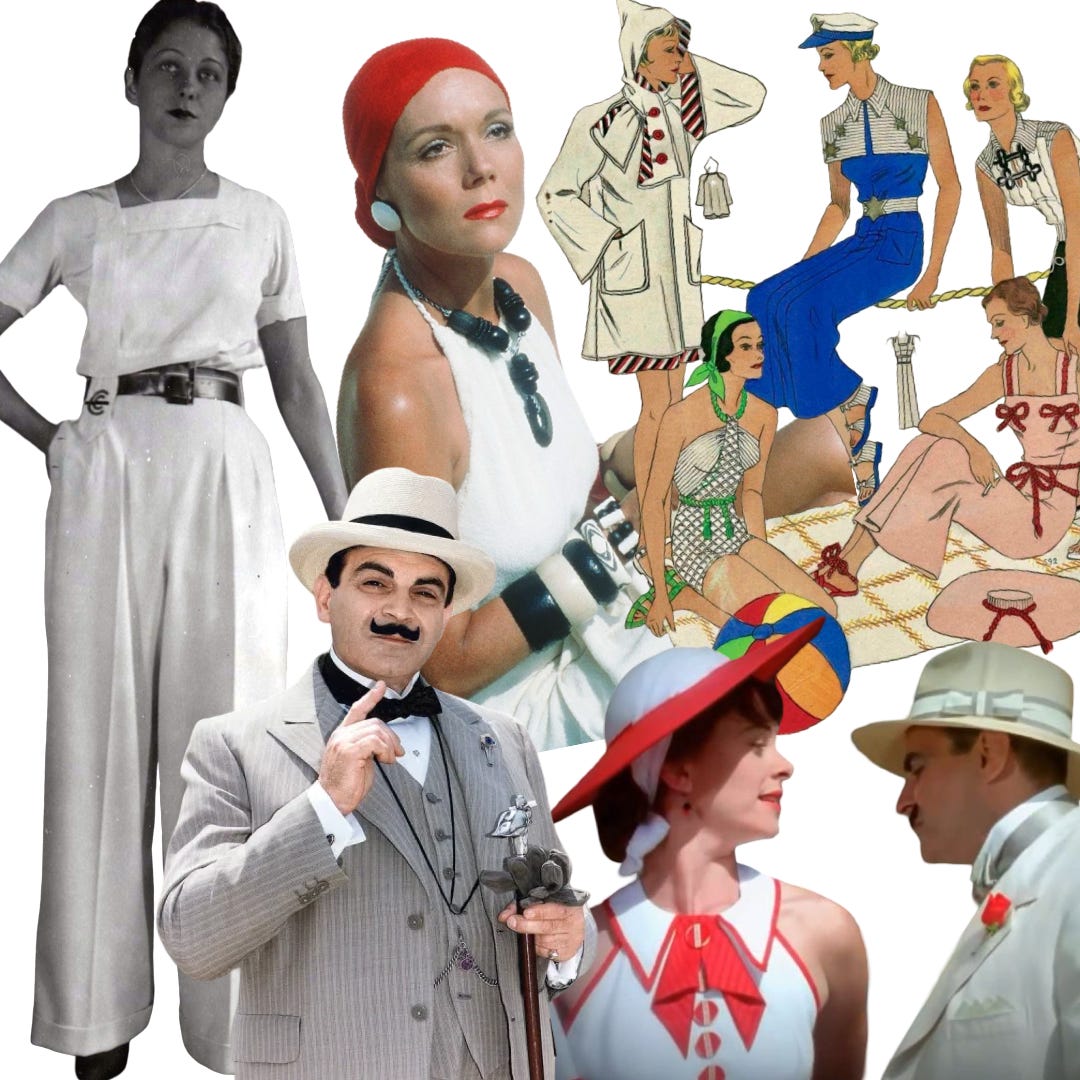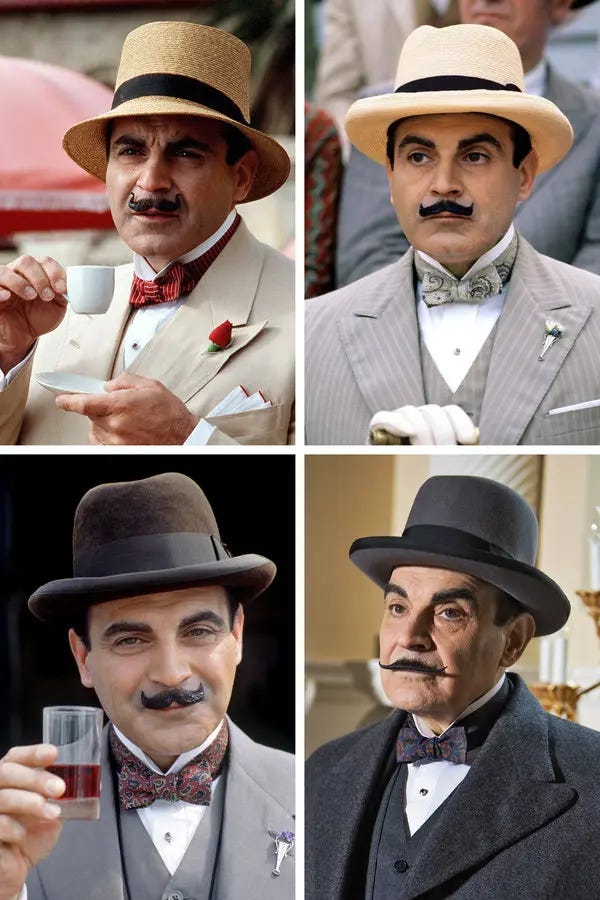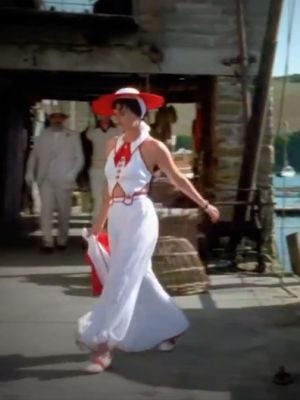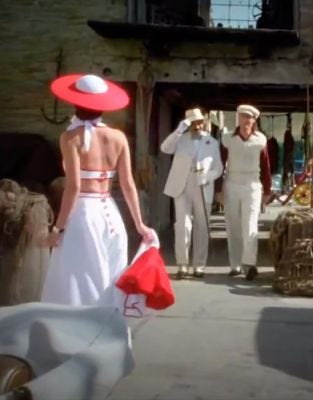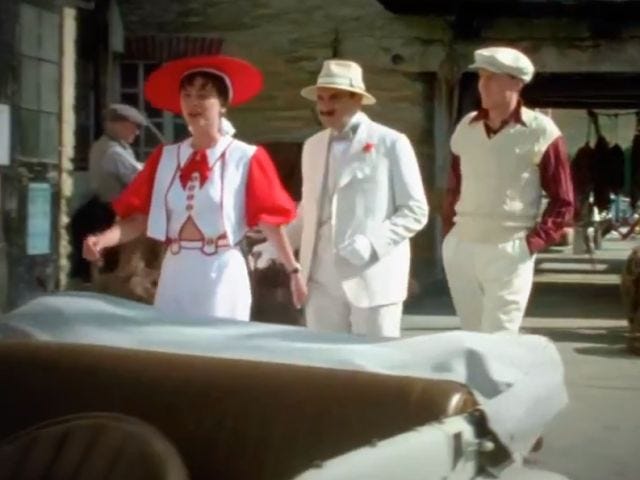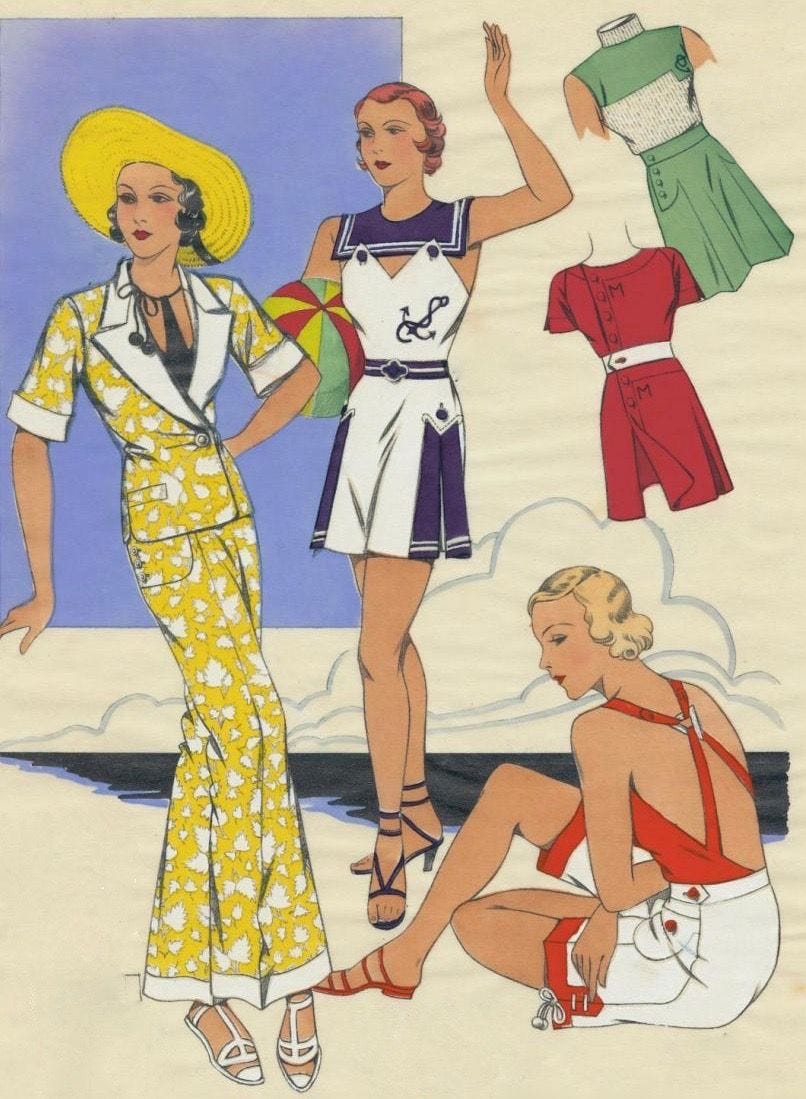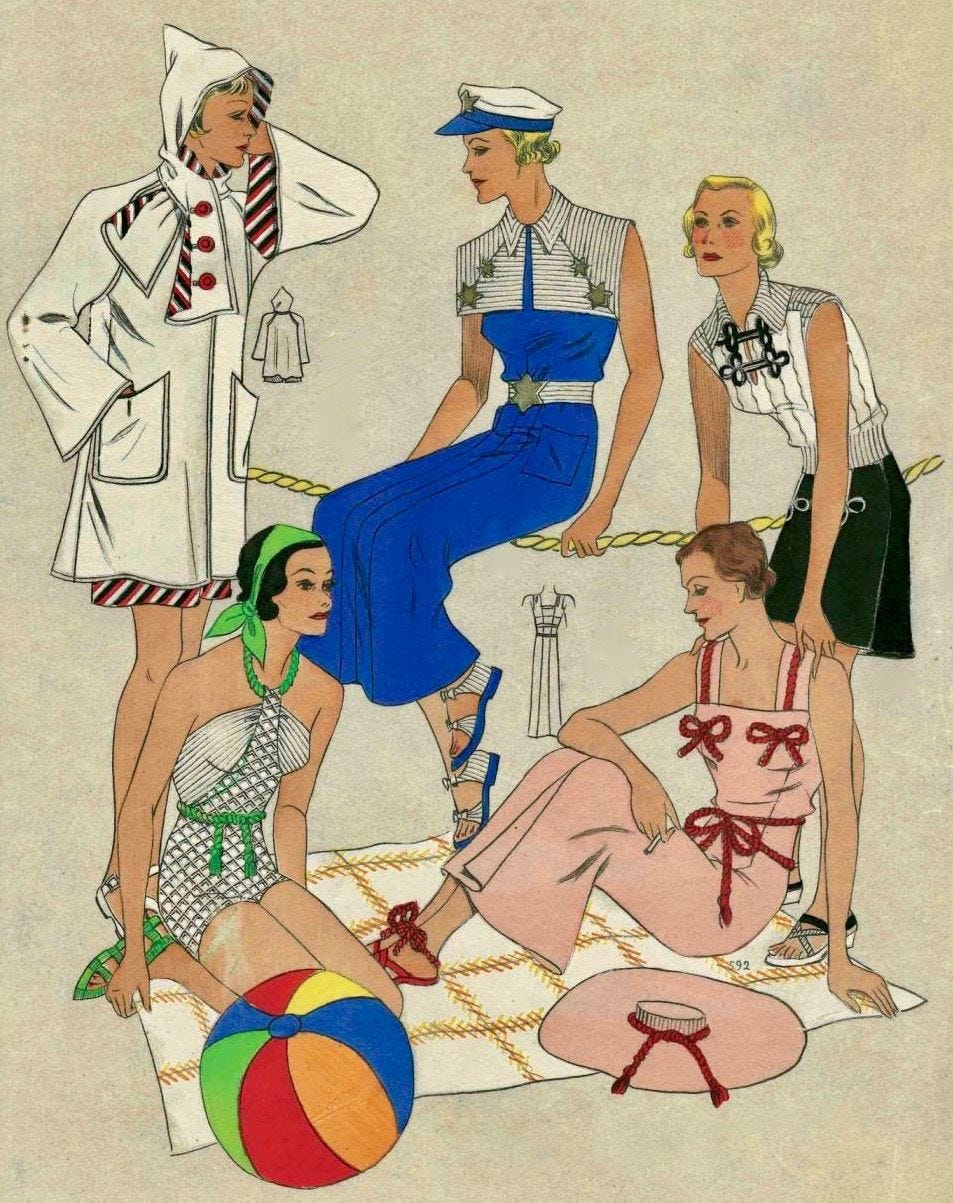How to Dress Like a Hercule Poirot Character: Summer Riviera Edition
In a world full of evil, the charming-but-complicated stylings of the 1930s call out to us.
Though summer has been deliriously gorgeous here in the Pacific Northwest, the state of the world’s evil (especially the referendum on gay marriage in the US, defunding of so many essential programs, and continued heinous genocide by Israel of Palestine) and my personal finances have led me to seek solace in the wiles and witticisms of ITV’s Hercule Poirot series, starring the inimitable David Suchet as Detective Poirot, who minces about and fusses but eventually prevails in the face of evil and injustice, as we should all aspire to (if you want to follow suit, a ton of full episodes are available for free on D*ilymotion, but you didn’t hear that from me).
Suchet’s humane, persnickety, both childlike and mature portrayal of Agatha Christie’s famous detective has me under its spell once again (I periodically go through phases of watching mystery shows that tend to veer toward levity and charm—I abhor true crime and anything that smacks of its tragedy porn energy), but this time, I’ve been especially taken with the 1930s stylings so perfected by its costume teams.
I am no historian, and if you want a delightful, easy watch on the specific subject of how authentic the costuming in Poirot was (an authenticity largely hinging on the fact that its costumers took into account the way real people would lag behind or jump ahead of the times sartorially, just as we do today), this thirty minute video essay "POIROT" - A Celebration of Style by The Ultimate Fashion History (who I understand tragically passed away fairly young shortly after this video was released) is just the ticket, covering the idiosyncracies of each main character’s wardrobe, from Poirot’s stuffy-but-sweet suits and spats to Hastings’ rakishly trendy garb to Ms. Lemon’s chic sweater sets. The video also dives into Angels, the likely supplier for most of the show’s wardrobe over its near-25-year run, the ways different classes and social statuses dressed during the economically and militarily turbulent inter-war period, and much more, all delivered in a soothing, humorous tone. It’s a true must-watch for Poirot fans and if I don’t cite something that seems cite-worthy in this piece, attribute it to this video.
I am not going to attempt much historicity in this post, as that’s not really my forté (I recommend LEWIS'S for more thoughtful reading, as they are very much on the same page as me in regard to 30s summer style, which I mention in more detail below the paywall), and maybe another time I’ll get to the fashion of our three main characters, much of which is hard to stomach on 98 degree days in its flurry of layers and starch and herringbone. Today, I’m thinking about the style represented in episodes of the show such as Peril at End House, Evil Under the Sun, and the infamous Death on the Nile (I BESEECH you not to watch the G*l G*dot version), stories that take place in warmer months and places necessitating breezy, light dressing. Summer dressing in the 30s largely manifested in a style called “Summer Riviera”: a dreamy, sun-drenched aesthetic that blended continental leisurewear with the influence of ocean liner travel, colonial tourism, and a growing sense of modernity and motion in fashion. Think: wide-legged linen trousers, crisply belted shirtdresses, open-weave knits, and the omnipresent panama hat. In the dire economy of the 30s, Summer Riviera was an aspirational, coded sartorial language of elegance, affluence, and escapism.
Thank you so much for reading! I’m still in dire financial straits, so subscribing to this blog (you can even do so for $1.50/month with this secret link) is more valuable to me now than ever. I am so grateful for your support and hope my odd musings get you thinking, one way or another.
If you like these posts, please let me know by liking and commenting here or on Esque’s Instagram, subbing to the Esque Substack (this) for free, getting bonus posts for five bucks a month, or for ZERO DOLLARS, share (tag me if on IG so I can see and thank you)! If you share with three friends (or enemies), you’ll automatically get a free month’s subscription to Esque’s paywalled posts. If you buy anything from an Esque link, there’s a chance I’ll earn a percentage commission at no cost to you—if you end up inspired by anything below, please send over a photo of your new togs by replying to this email and I’ll comp you a month of Esque!
If you cannot afford the $5/month, I totally understand—respond to any of my email sends and I will get you a $1.50 subscription or comp you, whatever you need. Esque is for everyone!
THANK YOU for being here, and I am always available @that.esque on Instagram for sartorial scandals/situations/summons. Here is a little preview of what’s below the paywall:
To understand Summer Riviera style as depicted in Poirot, you have to picture the intersection of practicality and pure fantasy. Born from the upper crust’s seasonal migration to warm coasts like the Côte d'Azur, Portofino, or even colonial outposts in North Africa, this style was all about dressing as if one belonged to the leisure class, whether or not one’s status measured up to the fantasy.
Summer Riviera is characterized by:
Lightweight natural fabrics—lots of cotton, linen, and silk crepe.
Pastel and nautical color palettes—predominantly white, red, cream, navy, coral, and sun-bleached yellows.
Art Deco-inflected accessories—chunky bakelite bangles, geometric sunglasses, woven handbags, and wide-brimmed hats.
Resortwear made elegant—e.g. flowing halter jumpsuits and backless bias-cut dresses with matching bolero jackets.
You’ll find this sensibility lovingly rendered in Poirot episodes I mentioned above such as Evil Under the Sun, where linen suits mingle with lamé gowns, or Death on the Nile, where chiffon scarves trail dramatically on breezy boat decks. However, the look that sucked me into this aesthetic was featured for just a few brief minutes on the stunning character Nick in the beloved episode Peril at End House.
This jumpsuit (?) with its geometric cut-outs, twee buttons, nautical details and matching accessories (BRING BACK THE BOLERO!) captured my heart in its brief appearance and despite the fact that these are the best-quality screen grabs I could get. Looks like this one in Poirot are never purely decorative—they reflect each woman’s social standing, personality, and even on occasion their moral alignment. The femme fatale tends to wear something slightly askew (a slit that’s a bit too high, a shade of red that’s a bit too bold), while ingénues are dressed in airy florals and frothy pastels. Characters like Nick, who I will without spoiling anything say is a bit of both categories, take cues from each angle and often congeal the aesthetics into something we NEVER see on today’s runways, beaches, or city streets.
Nick’s jumpsuit led me down a path of patterns that would have been the ticket to less-affluent fashionistas who would typically make their own clothes or take requests to a seamstress:
I’m especially obsessed with the stripe-lined rain jacket (?) and the braided rope bows on the pink set (a take on bows that WOULDN’T feel miserably overwrought in 2025).


